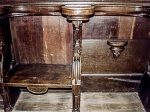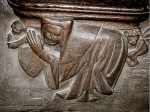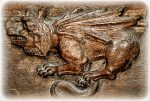The History and Mysteries of Europe’s Misericords Part I by Dave Douglas Davis
A couple of hours after sunset on the evening of January 29, 1497 a light frost settled over the fields outlying Villefranche-de-Rouergue. By the time Père Dominique arose from the wooden platform that served as his bed a little before two in the morning, the temperature hovered just below zero. His nostrils stung a little as he inhaled the thin night air.
It was a Tuesday in the Julian calendar that still served to calibrate the year, but the obligations of the aging cleric varied little from one day to the next. Throughout Europe, monks arose between midnight and 2:00 to commence their daily routine. Save for a short nap just before dawn, Dominique would not sleep again until well after dusk.
Gargoyles glared down from the eaves of La Collégiale Notre-Dame as Dominique entered the church with six other monks. They proceeded in single file through the nave, where the congregation would sit if there were a congregation at this predawn hour, and into the chancel, that most sacred area of the church, lining up along one side in the choir stalls that were reserved for clergy. When he reached his stall, he lifted the wooden seat so that he could stand for the beginning of le Nocturne, day’s first period of prayer of the day. On the underside of the folding seat was a small ledge where, as the day wore on, he could perch his tailbone and provide some relief for his legs.
- Misericords in St. Christopher Church, Baden Baden, Germany. Courtesy Elaine C. Block collection.
- Woman throws a bowl at a man who lifts the top of her cooking pot. Bristol Cathedral, United Kingdom. Courtesy misericords.co.uk.
The Mercy Seat
This mercy seat, or misericord (literally meaning mercy of the heart) would prove more and more useful as the monks’ day unfolded, for after le Nocturne there would be le Matin, followed by the other official duties of the Divine Office, or Opus Dei, spaced throughout the day: Lauds, Prime, Tierce, Sext, Nones, Vespers and finally the Compline, the final prayers just before sleep. In addition, each was expected to say a private mass, and all were required to attend High Mass.
In total, a monk of this period would devote five hours or more a day to formal prayer and masses, and most of that time would be spent standing with arms outstretched toward heaven. The daily routine was much the same with minor variations throughout the domain of the Church of Rome. Most of these hours of religious observance were spent in the choir (or quire).
Below the misericord platform on which Père Dominique leaned, now obscured by his robe, was an elaborately carved scene of a nude man exposing his buttocks to an individual who had a man’s body but the face of a dog. Or was it the face of an ape? Beneath the misericord platform under each choir stall seat was a different carved image. Some depicted scenes of everyday life like cooking or farm animals. Others displayed elaborately carved images of creatures that existed only in imagination.
- Cleric with devil and angel. Magdeburg Cathedral, Germany. Courtesy misericords.co.uk
- Horned dragon. Magdeburg Cathedral, Germany. Courtesy misericords.co.uk
Medieval imagination
Standing with one’s arms raised for five hours daily is trying even for a healthy adult, and it was especially difficult for monks who were elderly, or sick. In consideration of their frail condition, beginning in the Medieval period, most larger churches were designed to include choir stalls lined with seats that could be folded up to expose a narrow platform that would provide a support for weak or infirm monks to lean on during the conduct of the daily offices.
But it seems that the Medieval woodcarver rebelled against empty space. Rather than expose the eye to a blank wooden palette when the mercy seat was exposed to view, the craftsmen decorated the area below the wooden ledge with a remarkable array of subjects. And in contrast to what one might expect in this holiest of spaces, the topics of misericord carvings were often secular, and sometimes even profane.
- Dancing with a pig. St. Martin Church, Bolsward, Netherlands. Courtesy Elaine C. Block collection.
- Stealing a kiss. Chichester Cathedral, United Kingdom. Courtesy of misericords.uk.co.
What are we to make of such carvings? Not surprisingly, these kinds of “aberrant” misericords have attracted the attention of scholars, who have proposed various theories about them. Some have suggested that they were didactic reminders to the clergy to focus their sermons upon the real human conditions around them. Some instead have suggested that they represent the repressed side of the Medieval psyche, as per Jung’s theories. And yet others have argued that they are symbolic representations of church doctrine.
None of these theories has gained universal acceptance because, in truth, we have so little direct evidence of the intentions of the men who carved them.
In our second article Hidden Beneath the Seats – The History of the Misericords we’ll explore the origins and extent of the Mercy Seats in Europe. In the third and final Hidden Beneath the Seats – The Artisan’s Playground we’ll explore the iconography of misericords. From religious and mythological to downright bawdy illustrations in the Mercy Seats in Europe.
Learn more








